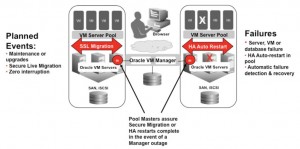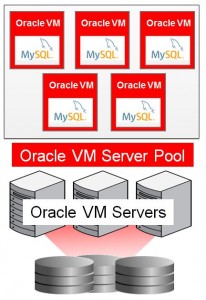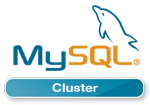As a reminder Oracle Virtual Manager provides a way to add High Availability to your MySQL deployment (this is separate from MySQL Replication and MySQL Cluster). The new OVM template provides a very convenient way to create one or more Virtual Machines that come pre-provisioned with OVM, Oracle Linux and MySQL Enterprise Edition as well as the scripts required to integrate MySQL into OVM’s HA features.
Archive for June 28, 2011
White Paper – Oracle VM Template for MySQL Enterprise Edition
Tweet
New – Oracle VM Template for MySQL Enterprise Edition
There are a couple of ways to look at the benefits:
- Provides a simple alternate High Availability solution for MySQL (i.e. rather than MySQL Replication or MySQL Cluster – although you can still set up replication to/from a MySQL Server installed this way)
- A new, very simple way to get up and running with MySQL Enterprise – running on a complete stack that Oracle can provide support for
As the focus of this blog is normally MySQL Cluster and Replication, the HA attributes of this solution are probably those of most interest. When you download the template and then load it into Oracle Virtual Machine (OVM) Manager and fire it up you get the chance to flag that you want it to be run in a HA mode. What this means is that:
- If the hardware, virtual machine, operating system or MySQL Server fail then the OVM Manager will recreate the VM on another physical server from the OVM Server Pool
- For routine hardware maintenance you can tell OVM Manager to migrate a running VM to another physical server
Note that the data files are actually stored on shared storage under Oracle Cluster File System 2 (OCFS2) which is how a newly instantiated replacement VM can get up and running quickly. As the original hardware (or the MySQL Server instance, OS or VM) could still fail without warning the MySQL Storage Engine must be crash-safe and so this should be used with InnoDB rather than MyISAM.
The complete software line-up looks like this:
- Oracle Linux 5 Update 6 with the Unbreakable Enterprise Kernel
- Oracle VM 2.2.1
- Oracle VM Manager 2.1.5
- Oracle Cluster File System 2 (OCFS2)
- MySQL Database 5.5.10 (Enterprise Edition) – InnoDB
Tweet
Webinar: Delivering Scalable and Highly Available Session Management with MySQL Cluster
Update – the webinar replay is now available from http://www.mysql.com/news-and-events/on-demand-webinars/display-od-630.html?clusterdb
There is a free webinar today (31st May) covering the use of MySQL Cluster in session management – register for free here. The session starts at 9:00 am Pacific, 17:00 UK, 18:00 Central European Time.
As organizations seek to enhance their users’ web experience through personalization based on historic browsing and buying behaviors, session data is becoming more critical. Larger volumes of session data need to be managed and persisted in real-time, and so session management has become increasingly performance-intensive, while also demanding very high levels of availability to ensure a seamless customer experience. In these scenarios, it makes sense to evaluate the MySQL Cluster database.
This is a practical session, demonstrating how to manage PHP session data with MySQL Cluster, and includes:
- Demands of session management
- Brief review of MySQL Cluster architecture
- Why MySQL Cluster is well placed to meet the demands from session management
- Getting a session management solution up and running with PHP and MySQL Cluster
- Performance optimization, including the latest enhancements to JOIN performance
- Case studies
Tweet
Webinar: MySQL Cluster, Scaling Web Databases with Auto-Partitioning and SQL/NoSQL Access
Update: webinar replay is now available from http://event.on24.com/r.htm?e=311660&s=1&k=3DCFE1CB3E1CF3F0FD0969DC66D93989
On Thursday 26th May Mat Keep and I will be presenting a webinar on how MySQL Cluster can deliver linear scalability – together with some tips on how to achieve it. As always the webinar is free but you need to register here.
The session starts on Thu, May 26 at 17:00 UK time, 18:00 Central European Time, 09:00 Pacific.
This webinar will discuss best practices in scaling services on-demand for high volumes of reads and writes, and provide insight on the range of NoSQL and SQL access methods available to developers, specifically covering:
- Automatic partitioning (sharding) for high scalability
- On-line scaling of the cluster across commodity hardware
- SQL and NoSQL interfaces, and what should be used when
- On-line updating of schema design to accommodate rapidly evolving applications
- Resources to get started
Tweet




